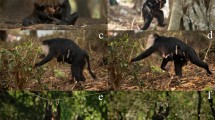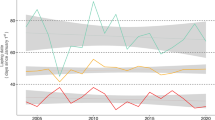Abstract
The amount of food delivered by parents to their chicks is affected by various life history traits as well as environmental and social factors, and this investment ultimately determines the current and future fitness of parents and their offspring. We studied parental provisioning behaviour in the Vinous-throated Parrotbill Paradoxornis webbianus, a species with an unusual social system that is characterised by flock-living, weak territoriality and variable nesting dispersion. Parental provisioning rate had a positive influence on chick mass gain, suggesting that provisioning rate is an effective measure of parental investment in this species. Males and females fed nestlings at approximately the same rate, and no other carers were observed at nests. Parents coordinated provisioning rates so that they mostly fed chicks synchronously. However, the extent to which parents coordinated provisioning was associated with their social environment, synchrony being positively related to local breeding density and negatively to nearest neighbour distance. The rate at which parents provisioned nestlings showed the same relationships with social measures, being greatest at higher density and when neighbours were closer. Visit rate was also related to chick age, but not to brood size, brood sex ratio, extra pair paternity, laying date, temperature, parents’ body characters, time of day or year. We conclude that a breeding pairs’ social environment plays an important role in determining parental investment, probably through its effects on the opportunities that parents have for foraging with conspecifics.




Similar content being viewed by others
References
Both C, Visser ME, Verboven N (1999) Density-dependent recruitment rates in great tits: the importance of being heavier. Proc R Soc B 266:465–469
Bouwman KM, Lessells CM, Komdeur J (2005) Male reed buntings do not adjust parental effort in relation to extrapair paternity. Behav Ecol 16:499–506
Burnham KP, Anderson DR (2002) Model selection and multimodel inference: a practical information-theoretic approach, 2nd edn. Springer, Berlin
Clutton-Brock TH (1991) The evolution of parental care. Princeton University Press, Princeton
Crawley MJ (2007) The R book. John Wiley & Sons, Chichester
Cresswell W (1994) Flocking is an effective anti-predation strategy in redshanks, Tringa totanus. Anim Behav 47:433–442
Dickinson JL (2003) Male share of provisioning is not influenced by actual or apparent loss of paternity in western bluebirds. Behav Ecol 14:360–366
Dixon A, Ross D, O’Malley SLC, Burke T (1994) Paternal investment inversely related to degree of extra-paternity in the reed bunting. Nature 371:698–700
Elgar MA (1989) Predator vigilance and group size in mammals and birds. Biol Rev 64:13–33
Ewen JG, Armstrong DP (2000) Male provisioning is negatively correlated with attempted extrapair copulation frequency in the stitchbird (or hihi). Anim Behav 60:429–433
Falconer CM, Mallory M, Nol E (2008) Breeding biology and provisioning of nestling snow buntings in the Canadian High Arctic. Polar Biol 31:483–489
Fretwell SD, Lucas HL (1969) On territorial behavior and other factors influencing habitat distribution in birds. Acta Biotheor 19:16–36
Griffiths R, Double MC, Orr K, Dawson RJG (1998) A DNA test to sex most birds. Mol Ecol 7:1071–1075
Hatchwell BJ (1999) Investment strategies of breeders in avian cooperative breeding systems. Am Nat 154:205–219
Hinde CA (2006) Negotiation over offspring care?—a positive response to partner-provisioning rate in great tits. Behav Ecol 17:6–12
Holmes RT, Marra PP, Sherry TW (1996) Habitat-Specific demography of breeding black-throated blue warblers (Dendroica caerulescens): implications for population dynamics. J Anim Ecol 65:183–195
Houston AI, Davies NB (1985) The evolution of cooperation and life history in the dunnock, Prunella modularis. In: Sibly RM, Smith RH (eds) Behavioural ecology. Blackwell Scientific, Oxford, pp 471–487
Johnstone RA, Hinde CA (2006) Negotiation over offspring care—how should parents respond to each other’s efforts? Behav Ecol 17:818–827
Kim CH (1998) Social behaviour of the Crow Tit (Paradoxornis webbiana) during the breeding season. Korean J Ornithol 5:17–26
Kim CH, Yamagishi S, Won PO (1995) Breeding biology of the Crow Tit (Paradoxornis webbiana). Korean J Ornithol 2:1–10
Krause J, Ruxton GD (2002) Living in group. Oxford University Press, New York
Lee JW, Jang B-S, Dawson DA, Burke T, Hatchwell E (2009a) Fine-scale genetic structure and its consequence in breeding aggregation of a passerine bird. Mol Ecol 18:2728–2739
Lee JW, Kim M-S, Burke T, Hatchwell BJ (2009b) Extrapair paternity in a flock-living passerine, the vinous-throated parrotbill Paradoxornis webbianus. J Avian Biol 40:469–474
Lima SL (1995) Back to the basics of anti-predatory vigilance: the group-size effect. Anim Behav 49:11–20
Lindén M, Møller AP (1989) Cost of reproduction and covariation of life history traits in birds. Trends Ecol Evol 4:367–371
Lindén M, Gustafsson L, Pärt T (1992) Selection on fledging mass in the collared flycatcher and the great tit. Ecology 73:336–343
MacColl ADC, Hatchwell BJ (2002) Temporal variation in fitness payoffs promotes cooperative breeding in long-tailed tits Aegithalos caudatus. Am Nat 160:186–194
Magrath RD (1991) Nestling mass and juvenile survival in the blackbird Turdus merula. J Anim Ecol 60:335–351
Naef-Daenzer B (2000) Patch time allocation and patch sampling by foraging great and blue tits. Anim Behav 59:989–999
Naef-Daenzer B, Keller LF (1999) The foraging performance of great and blue tits (Parus major and P. caeruleus) in relation to caterpillar development, and its consequences for nestling growth and fledging weight. J Anim Ecol 68:708–718
Naef-Daenzer L, Naef-Daenzer B, Nager RG (2000) Prey selection and foraging performance of breeding Great Tits Parus major in relation to food availability. J Avian Biol 31:206–214
Nakagawa S, Cuthill I (2007) Effect size, confidence interval and statistical significance: a practical guide for biologists. Biol Rev 82:1–15
Nishiumi I, Yamagishi S, Maekawa H, Shimoda C (1996) Paternal expenditure is related to brood sex ratio in polygynous great reed warblers. Behav Ecol Sociobiol 39:211–217
Nur N (1984) Feeding frequencies of nestling blue tits (Parus caeruleus): costs, benefits and a model of optimal feeding frequency. Oecologia 65:125–137
Peterson KA, Thusius KJ, Whittingham LA, Dunn PO (2001) Allocation of male parental care in relation to paternity within and among broods of the common yellowthroat (Geothlypis trichas). Ethology 107:573–586
R Development Core Team (2008) R: A language and environment for statistical computing. R Foundation for Statistical Computing, Vienna, Austria
Rands SA, Cowlishaw G, Pettifor RA, Rowcliffe JM, Johnstone RA (2003) Spontaneous emergence of leaders and followers in foraging pairs. Nature 423:432–434
Ranta E, Rita H, Lindstrom K (1993) Competition versus cooperation: success of individuals foraging alone and in groups. Am Nat 142:42–58
Ranta E, Peuhkuri N, Hirvonen H, Barnard CJ (1998) Producers, scroungers and the price of a free meal. Anim Behav 55:737–744
Roberts G (1996) Why individual vigilance declines as group size increases. Anim Behav 51:1077–1086
Sanz JJ, Tinbergen JM (1999) Energy expenditure, nestling age, and brood size: an experimental study of parental behavior in the great tit Parus major. Behav Ecol 10:598–606
Sethi VK, Bhatt D (2007) Provisioning of young by the oriental magpie-robin (Copsychcus saularis). Wilson J Ornithol 119:356–360
Shapiro SS, Wilk MB (1965) An analysis of variance test for normality (complete samples). Biometrika 52:591–611
Sillett TS, Rodenhouse NL, Holmes RT (2004) Experimentally reducing neighbor density affects reproduction and behavior of a migratory songbird. Ecology 85:2467–2477
Tinbergen JM, Boerlijst MC (1990) Nestling weight and survival in individual great tits Parus major. J Anim Ecol 59:1113–1127
Valencia J, De La Cruz C, Carranza J, Mateos C (2006) Parents increase their parental effort when aided by helpers in a cooperatively breeding bird. Anim Behav 71:1021–1028
Westerdahl H, Bensch S, Hansson B, Hasselquist D, von Schantz T (2000) Brood sex ratios, female harem status and resources for nestling provisioning in the great reed warbler (Acrocephalus arundinaceus). Behav Ecol Sociobiol 47:312–318
Wright J (1998) Paternity and parental care. In: Birkhead TR, Møller AP (eds) Sperm competition and sexual selection. Academic Press, London, pp 117–139
Acknowledgments
We thank Andrew MacColl, Stuart Sharp, Terry Burke and two anonymous referees for their valuable comments on the manuscript and Shinichi Nakagawa for statistical advice. We also thank Byoung-Soon Jang, Jeong-Chil Yoo, Myon-Sik Kim and Yun-Kyoung Lee for their invaluable help in the field, Chun-Geun Kim who kindly provided accommodation during fieldwork and many residents in the study area for kindly allowing us to observe birds on their property. Kind help by Andy Krupa, Gavin Hinten, Michelle Simeoni and Deborah Dawson was crucial for the genotyping and molecular sexing of the birds. Bird ringing and blood sampling were conducted under permits issued by Yangpyeong-gun county, and this work was partly funded by the University of Sheffield, for which we are most grateful.
Author information
Authors and Affiliations
Corresponding author
Additional information
Communicated by T. Friedl.
Rights and permissions
About this article
Cite this article
Lee, JW., Kim, HY. & Hatchwell, B.J. Parental provisioning behaviour in a flock-living passerine, the Vinous-throated Parrotbill Paradoxornis webbianus . J Ornithol 151, 483–490 (2010). https://doi.org/10.1007/s10336-009-0484-1
Received:
Revised:
Accepted:
Published:
Issue Date:
DOI: https://doi.org/10.1007/s10336-009-0484-1




